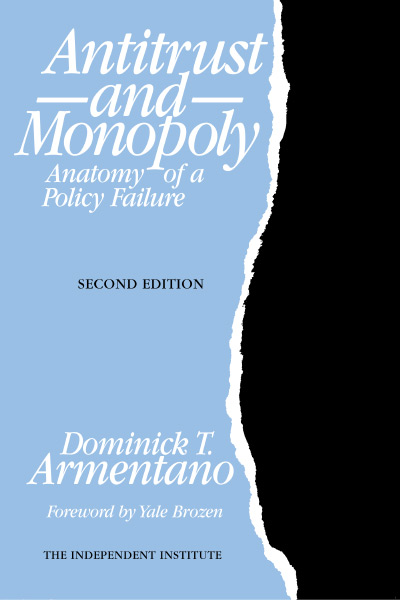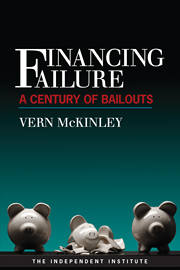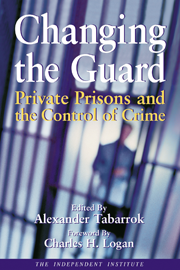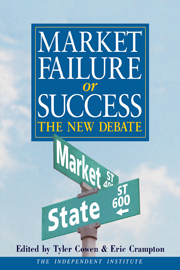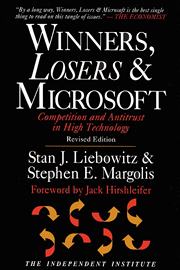| List Price: | ||
| Price: | $16.95 | |
| Discount: | $3.00 (Save 15%) |
| Formats |
Paperback |
eBook |
| List Price: | ||
| Price: | $16.95 | |
| Discount: | $3.00 (Save 15%) |
| Formats |
Paperback |
eBook |
Overview
Is antitrust law a necessary defense against the predatory business practices of wealthy, entrenched corporations that dominate a market? Or does antitrust law actually work to restrain and restrict the competitive process, injuring the public it is supposed to protect? In this breakthrough study, Professor Armentano thoroughly researches the classic cases in antitrust law and demonstrates a surprising gap between the stated aims of antitrust law and what it actually accomplishes in the real world. Instead of protecting competition, Professor Armentano finds, antitrust law actually protects certain politically-favored competitors. This is an essential work for anyone wishing to understand the limitations and problems of contemporary antitrust actions.
Contents
- Chapter 1: The Legitimacy of Antitrust Policy
- Chapter 2: Competition Theory and the Market Economy
- Chapter 3: Monopoly Under the Sherman Act
- Chapter 4: Monopoly in Business History
- Chapter 5: Price Conspiracy and Antitrust Law
- Chapter 6: Price Discrimination and the Competitive Process
- Chapter 7: Typing Agreement and Antitrust Policy
- Chapter 8: Mergers, Competition, and Antitrust Policy
- Chapter 9: The Antitrust Laws and a Free Society
Detailed Summary
- Antitrust laws have always been used to protect less efficient firms from the rigors of the competitive process. This protectionism is most obvious in the private cases—95 percent of all antitrust—but it is also evident in the classic government cases as well. Antitrust attacks on firms such as IBM, United Shoe Machinery, DuPont, Procter & Gamble, and Alcoa have had the economic effect of sheltering less efficient business organizations. Antitrust restrictions on business mergers have had the economic effect of protecting entrenched managers and corporate assets from efficient reorganization. Antitrust restrictions on price reductions, price discrimination, and tying agreements have all served to protect inefficient competitors and harm consumers.
- Real monopoly power has always been immune from antitrust regulation. Local telephone service and cable TV service are a monopoly by law. Government licensing and tariff protection restrict competition and generate monopoly “rents” for privileged private interests. Only government supported cartels (agriculture, transportation, oil production) have ever been able to establish long-run monopoly prices. Deregulation, not antitrust, is the road to efficient, well-organized markets.
- Antitrust judgments are little more than “hunches” and can hold no scientific claim to increasing social welfare. Rule of reason analysis in antitrust assumes that government and judicial decision makers have access to economic information concerning social costs and benefits. For example, the regulators may decide that market prices are too high or too low; that specific corporate assets (AT&T) must be divested; that specific mergers and joint ventures are not in the public interest; or that resale price maintenance agreements are inefficient and should be prohibited. Yet costs and benefits are personal and subjective, and cannot be aggregated and compared as the rule of reason naively assumes.
- The antitrust laws are a civil liberties nightmare. Given the vagueness of the statutes, it is inherently unclear which tying agreements, mergers, or dealer terminations violate the law. Business people can be convicted for complaining (talking) about prices. Firms are often “turned in” by their business rivals. Judicial remedies apply only to the convicted even though the questioned practice may be widespread throughout the industry. Even Adam Smith was forced to admit that a law prohibiting price collusion could not be made “consistent with liberty and justice.”
- The historical origins of the nation’s first antitrust law, the Sherman Act, as with all antitrust legislation, are tainted with self-interest and business protectionism. Senator Sherman and other Republicans hoped that the law could help distract public attention from their support for higher protective tariffs that helped big business. Anti-labor interests hoped that the new law would be used to stifle the growth of unions and collective bargaining. And small business hoped that the law would be used to stifle the efficient growth of the large trusts. So much for the public interest origins of antitrust laws.
Corporate mergers and so-called hostile takeovers are making big headlines. The Supreme Court opened the door to state and private challenges to mergers, while among the many allegations against Michael Milken, the “junk bond king,” was the charge that he financed takeovers. This hysterical atmosphere may breath new life into the nation’s myriad and complex antitrust laws, after they had fallen into disfavor and disuse. President Bush’s appointments to the Justice Department and the Federal Trade Commission seem less inclined to continue Reagan’s reign of “salutary neglect.”
The lurid headlines, unfortunately, are so obsessed with the plight of investors and managers that they never consider the consumer. Yet a new foray into antitrust enforcement would spell disaster. That is why it is particularly appropriate that the Independent Institute has brought out a new edition of Antitrust and Monopoly: Anatomy of a Policy Failure.
The author of this searching and scathing indictment is Dominick T. Armentano, professor of economics at the University of Hartford. In addition to the author’s revised introduction, the new edition features a foreword by Yale Brozen, Professor Emeritus at the University of Chicago’s Graduate School of Business.
Antitrust in Theory
The alleged purpose of antitrust laws is to foster competition. The popular fear is that without them monopolies will restrict output, drive up prices, and thereby gouge the consumer. But as Armentano argues, this fear is grounded in superficial or unrealistic economic theories. These theories compare the structure of existing markets with some abstract ideal, usually perfect competition. It then becomes the government’s job to wrench this structure into conformity with the ideal.
Antitrust and Monopoly shows that perfect competition can never be achieved in the real world. The standard makes such arbitrary assumptions as totally homogeneous and unchanging products, atomistic hordes of suppliers who have no individual impact on prices, and the possession of all relevant information by all market participants. Armentano, in contrast, following in the venerable tradition of the Austrian school of economists (e.g., Ludwig von Mises, F.A. Hayek, and Joseph Schumpeter), views competition as a process rather than as a structure.
Competition results from the dynamic efforts of profit-seeking entrepreneurs operating with imperfect information to coordinate production with the desires of consumers. The static theory of perfect competition not only subjects the market to an impossible ideal. It condemns antitrust enforcement to a war against the very competitive practices and innovations that entrepreneurs can profitably employ to better serve consumers. “Attempts to base antitrust judgments on [these models],” argues Armentano, necessarily lead to “economically absurd cases with harmful social consequences.”
Antitrust in Practice
Antitrust fares badly in theory; it comes out even worse in practice. There are already many fine critiques of antitrust theory, and other scholars have challenged either the recent excesses of antitrust enforcement or its application in limited cases. The unique contribution of Antitrust and Monopoly is to survey the entire range of U.S. cases, beginning at the very first antitrust law, the Sherman Act, passed one hundred years ago exactly.
Armentano concludes that “there was no ‘golden age’ when monopolistic abuse was running rampant in a free market and when, accordingly, antitrust policy was magnificently relevant.” Despite an exhaustive examination of every major antitrust case to reach the Supreme Court, Antitrust and Monopoly can find no single substantiated instance of a private monopoly harming consumers through output restrictions and price hikes. Instead, the government in all these cases stifled competitive practices that were benefiting consumers. The only victims of these supposed monopolistic practices were other competitors who could not serve the consumers as efficiently.
Consider the classic 1911 antitrust case: Standard Oil of New Jersey. The Standard Oil Company did at one time account for 88 percent of the market for petroleum products. Yet this unusual dominance had resulted from the company’s amazing efficiency, which had been consistently passed on to consumers in the form of ever lower prices. Moreover, new competitors had whittled down Standard Oil’s share to 68 percent by the time the government instituted its antitrust action. Yet, in deciding for the government, the courts never bothered to look at any economic analysis. Even today, there is absolutely no evidence that Standard Oil ever engaged in any practice that harmed consumers.
The common myth—that efficiency monopolies first destroy all competitors with predatory pricing, then recoup their losses with sky-high prices—has absolutely no historical foundation. The Standard Oil case does not substantiate it. Nor does Antitrust and Monopoly’s painstaking review of the remaining record turn up any other documented instance.
A second case, however, detailed in Antitrust and Monopoly shows the bizarre twists and harmful outcomes that antitrust often entails. The case arose out of the Clayton Act’s prohibition against tying agreements. Standard Oil of California had exclusive contracts with California gasoline stations representing only 6.7 percent of the market in 1949, and this share was declining. Moreover, these contracts typically lasted for only six months. Standard’s major competitors had been employing identical contracts since 1938 and together supplied a larger share of the market. And the courts conceded that the contracts reduced costs. Nevertheless, they prohibited Standard Oil of California’s use of these contracts.
Perhaps no case helps Armentano more explicitly reveal the bankruptcy of antitrust logic than the Brown Shoe case of 1962. It involved a 1956 merger between the Brown Shoe Company and the G. R. Kinney Company. In supporting the lower court decision that struck down the merger, Chief Justice of the Supreme Court Earl Warren fully admitted that “of course, some of the results of large integrated or chain operations are beneficial to consumers.” But the benefits were immaterial. “Congress appreciated,” Warren added, “that occasional higher costs and prices might result from the maintenance of fragmented industries and markets. It resolved these competing considerations in favor of decentralization. We must give effect to that decision.”
The Real Source of Monopoly
In case after case, Antitrust and Monopoly discovers the same pattern repeated with abysmal regularity. Antitrust laws, rather than restraining monopoly, actually restrain competition. “The entire antitrust system,” writes Armentano, “—allegedly created to protect competition and increase consumer welfare—has worked, instead, to lessen business competition and lessen the efficiency and productivity associated with the free-market process. Like many other governmental interventions, antitrust has produced results that are far different from those that were allegedly intended.”
In the final analysis, Antitrust and Monopoly offers a stark demonstration that government rather than the market is the ultimate source of monopoly. “The only principled and practical way to end monopoly power is to end it at its source. Government regulation, entry control, subsidization, and antitrust are all manifestations of a governmental interventionist power that has been employed by private firms to private advantage and to the detriment of society.” The only viable way to end monopoly, concludes Armentano, is to “end governmental interventionist power, including antitrust, and... create a free and open society were individuals can fulfill their own vision of the good society.”
Praise
“Skillfully honed, . . . eloquent, . . . Professor Armentano’s book must be mastered by all who would be heard on this issue.” —BUSINESS HISTORY REVIEW
“For anyone wanting to know what’s behind today’s headlines, Antitrust and Monopoly is an attractive introduction. With impressive scholarship, Armentano exposes the mythology around antitrust law. Classic antitrust cases are analyzed so thoroughly that this book should be required reading in economics and law, and by every Congressman.” —YALE BROZEN, Professor Emeritus of Economics, Graduate School of Business, University of Chicago
“Grounded solidly, Antitrust and Monopoly is one of the better examples of the anti-antitrust school of thought. Armentano provides valuable insight.” —BUSINESS HORIZONS
“Antitrust and Monopoly is the single best book-length treatment of this vital public policy issue in print, and it should become a, if not the standard work in economics, history, and political science.” —PUBLIC CHOICE
“Armentano’s book illuminates the paradox of antitrust law and policy: Should the law protect competition or competitors? The book is written in a very clear, concise, and declarative manner, which makes it accessible to students as well as interested professionals.” —ANTITRUST BULLETIN
“Antitrust and Monopoly should be on the reading list of every course in antitrust in law schools, business schools, and departments of economics. The economic background of landmark litigation is set forth at greater length than in alternative treatments. Clearly stated and rigorously developed, the book is definitely for professors as well as students. Critics of antitrust will find that the case against it is even stronger than they had thought. Friends of antitrust will be left in no doubt about the case that they have to answer if the policy is to regain intellectual respectability.” —DONALD DEWEY, Professor of Economics, Columbia University
Author
Dominick T. Armentano is Professor Emeritus of Economics at the University of Hartford.

